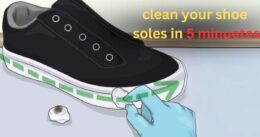Understanding The Importance Of Clean Shoe Soles
Dirty shoe soles not only affect the overall appearance of your shoes but can also have a significant impact on their longevity and your hygiene. You may need to clean your shoe soles regularly to maintain their durability and cleanliness.
Let’s explore why it’s crucial to pay attention to the cleanliness of your shoe soles.
Exploring The Impact Of Dirty Soles On Shoe Longevity
- Dirt and debris accumulated on shoe soles can act as abrasives, causing wear and tear on the shoe material over time.
- Grains of sand, small rocks, and other rough particles can get lodged in the sole grooves, resulting in damage to the sole structure.
- The accumulation of dirt and residue can lead to isolated deterioration and weaken the shoe’s overall integrity.
The Relationship Between Clean Soles And Personal Hygiene
- Unclean shoe soles can track in bacteria, fungi, and other harmful microorganisms from the ground, posing a risk to your health and the cleanliness of your living space.
- These microorganisms can thrive in the dark, moist environment provided by dirty shoe soles, potentially causing foot infections and unpleasant odours.
- When you step on unsanitary surfaces and then walk indoors without cleaning your shoe soles, you risk transferring germs and dirt onto your floors, carpets, and other surfaces.
Taking the time to clean your shoe soles regularly not only helps maintain their appearance but also contributes to the overall hygiene of your feet and living environment. By implementing a few simple cleaning habits, you can extend the lifespan of your shoes while promoting a clean and healthy space for yourself and others.
So, let’s dive into some effective shoe sole cleaning techniques in our next blog post section.
Assessing Different Types Of Shoe Soles
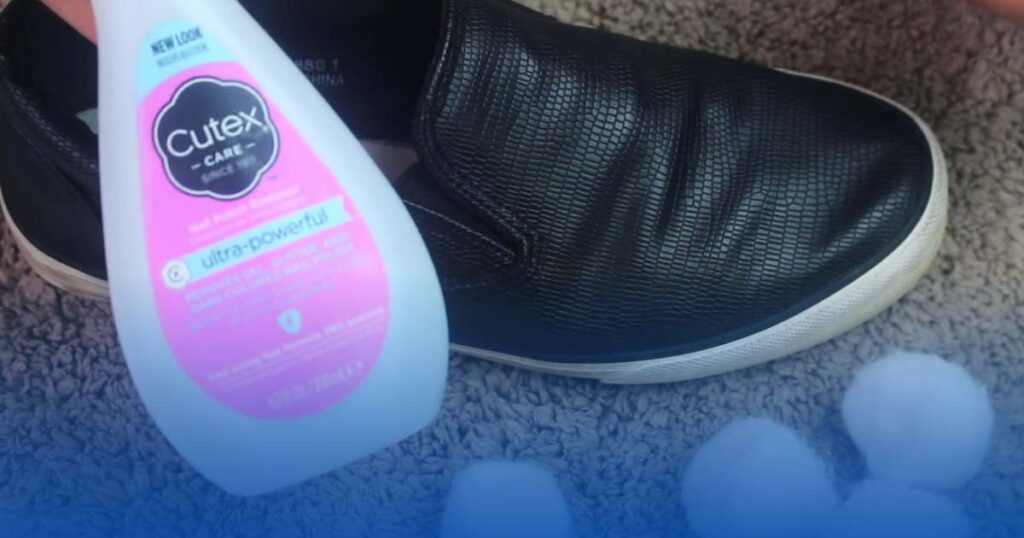
Highlighting The Variety Of Shoe Soles Available In The Market
When it comes to shoe soles, there are plenty of options in the market. Shoe manufacturers offer a wide range of sole materials to suit various needs and preferences. Each type of sole has its distinct characteristics that impact not only the durability and comfort of the shoe but also the cleaning and maintenance process.
Let’s explore the different types of shoe soles and understand their unique features.
Discussing The Distinct Characteristics Of Rubber, Leather, And Synthetic Soles
Rubber Soles:
- Rubber soles are one of the most popular choices for shoe soles thanks to their exceptional durability and flexibility.
- These soles provide excellent traction and grip, making them ideal for various activities, especially outdoor sports.
- Rubber soles are resistant to wear and tear, making them a long-lasting option for everyday shoes.
- Cleaning rubber soles is relatively easy, as they can be wiped clean with a damp cloth or gently scrubbed with mild soap and water.
Leather Soles:
- Leather soles are known for their classic and timeless appeal, commonly found in dress shoes and formal footwear.
- These soles are typically made from high-quality leather, offering superior comfort and breathability.
- Leather soles require extra care and maintenance as they are susceptible to water damage and wear over time.
- To clean leather soles, it’s best to use a soft, damp cloth and a leather conditioner to prevent drying out or cracking.
Synthetic Soles:
- Synthetic soles, such as those made from materials like polyurethane (PU) or ethylene-vinyl acetate (EVA), are lightweight and versatile.
- These soles are often found in athletic shoes and sneakers, providing cushioning and shock absorption.
- Synthetic soles are generally more resistant to water and stains, making them easier to clean and maintain.
- To clean synthetic soles, a simple mixture of mild detergent and warm water can be used, followed by gentle scrubbing with a soft brush.
The Role Of Sole Material In Determining The Cleaning Method
The type of sole material plays a crucial role in determining the appropriate cleaning method. Understanding the specific requirements of each exclusive kind can help you maintain the longevity and appearance of your shoes. Here’s how the exclusive material influences the cleaning approach:
- Rubber soles: Wipe clean with a damp cloth or gently scrub with mild soap and water.
- Leather soles: Clean with a soft, damp cloth and use a leather conditioner to prevent drying and cracking.
- Synthetic soles: Use a mixture of mild detergent and warm water, followed by gentle scrubbing with a soft brush.
By adhering to the recommended cleaning methods, you can keep your shoe soles in excellent condition and ensure their longevity. Remember to choose the technique that suits the sole material of your shoes to achieve the best results.
Essential Tools For Cleaning Shoe Soles
Cleaning the soles of your shoes is an essential step in maintaining their overall cleanliness and extending their lifespan. To effectively clean shoe soles, you’ll need a few basic tools and supplies. Here’s an overview of the must-have items you’ll want to have on hand:
- Brushes:
- Stiff-bristled brush: Perfect for removing dirt and debris from the grooves and crevices of your shoe soles.
- Soft-bristled brush: Ideal for gentle cleaning and buffing of the sole surface.
- Cloths:
- Microfiber cloth: Excellent for wiping away excess dirt and grime, as well as for applying cleaning solutions.
- Soft cloth: Essential for drying your shoe soles after cleaning to prevent water damage.
- Cleaning solutions:
- Mild soap and water: A simple solution of mild soap and warm water can effectively remove everyday dirt and stains.
- Vinegar and water: A mixture of vinegar and water works wonders in removing stubborn stains and odour.
- Rubbing alcohol: Use this solution for a deep clean, especially for getting rid of sticky residue or gum.
- Toothbrush or toothpick: These smaller tools are helpful for detailed cleaning, especially in hard-to-reach areas and tight crevices.
Organic And Homemade Alternatives
For those who prefer environmentally friendly options, several organic and homemade alternatives can effectively clean shoe soles. Here are a few options to consider:
- Baking soda paste: Create a paste by mixing baking soda with a bit of water. This paste helps to remove tough stains and leaves your soles fresh and clean.
- Lemon juice: The natural acidity of lemon juice makes it an excellent cleaner. Squeeze fresh lemon juice onto a cloth or pour it into a spray bottle, then wipe or spray it onto your shoe soles to remove dirt and stains.
- White vinegar: Mix equal parts white vinegar and water in a spray bottle. Spray the solution onto your shoe soles, let it sit for a few minutes, and then scrub with a brush or cloth.
- Hydrogen peroxide: This versatile household item can be effective in removing stains and killing bacteria. Apply a small amount to a cloth or sponge and scrub your shoe soles gently.
- Saltwater solution: Dissolve salt in warm water to create a natural cleaning solution. Dip a cloth or sponge into the solution and scrub your shoe soles to remove dirt and grime.
Remember to always test any cleaning solution on a small, inconspicuous area of your shoe soles before applying it to the entire surface to ensure it doesn’t cause any damage. With these essential tools and organic alternatives, you’ll be well-equipped to keep your shoe soles clean and looking their best.
Preparing Soles For Cleaning
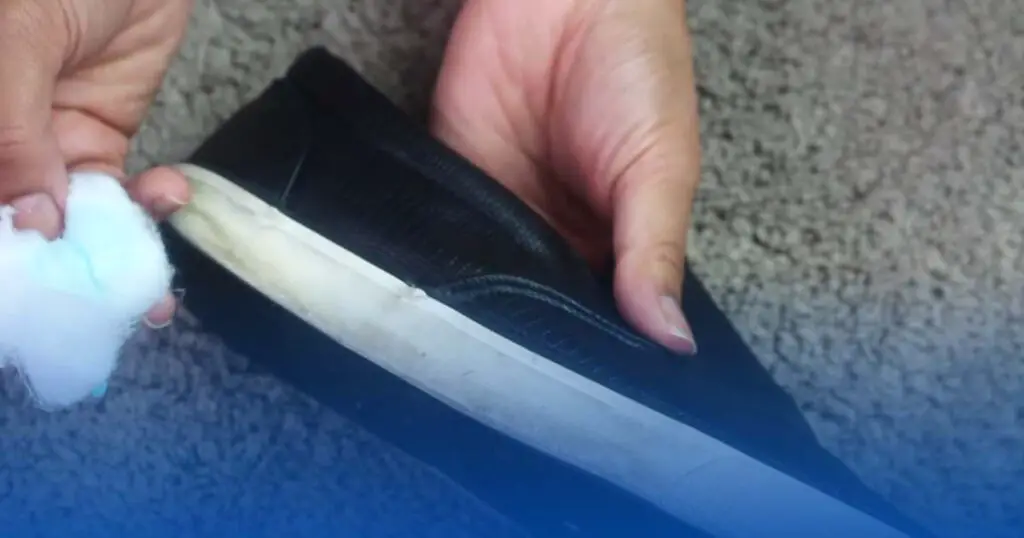
Examining Different Pre-Cleaning Techniques For Shoe Soles:
Before diving into the actual cleaning process, it’s essential to prepare your shoe soles properly. This step will help ensure better results in removing dirt and grime. Here are some techniques you can consider:
- Brushing: Using a stiff-bristled brush, gently scrub the soles to loosen any dirt or debris stuck on the surface. This method works well for most types of shoe soles.
- Wiping: For shoes with a smoother sole surface, such as leather or rubber, wiping the soles with a damp cloth can effectively remove loose dirt and debris. Make sure to use a mild cleaning solution if necessary.
- Scraping: If your shoe soles have stubborn dirt or mud buildup, gently squeezing them with a plastic spatula or an old credit card can help loosen and remove the debris. Be careful not to damage the sole material in the process.
- Soaking: Some shoe soles, especially those made of porous materials like canvas or fabric, may benefit from a pre-cleaning soak. Fill a basin with warm water and a small amount of mild detergent, then allow the soles to soak for a few minutes. This can help loosen dirt and stains before proceeding with the cleaning process.
Remember, the best pre-cleaning technique for your shoe soles may depend on the material and level of dirtiness. Take the time to examine your shoes and choose the method that suits them best.
Tips On Removing Loose Dirt And Debris From The Soles:
Now that you’ve prepared the shoe soles, it’s time to focus on getting rid of any loose dirt and debris clinging to them. Here are some helpful tips:
- Use a toothbrush: A toothbrush with bristles that are not too soft or too hard can be a handy tool for removing small particles from the sole grooves or hard-to-reach areas. Gently scrub the soles in a back-and-forth motion to dislodge the dirt.
- Tap the shoes: Holding the shoe upside down, give it a few firm taps on a solid surface. This technique can shake loose dirt and debris off the soles, making them easier to clean.
- Compressed air: If you have access to compressed air, you can use it to blow away loose dirt and dust from the soles. Be cautious when using this method, as excessive air pressure may damage certain delicate materials.
- Vacuum cleaner: If there is significant loose dirt on the soles, you can try vacuuming them using a brush attachment. This method can be beneficial for removing more significant bits of debris.
By following these tips, you can effectively eliminate loose dirt and debris from your shoe soles before moving on to the actual cleaning process.
Properly Handling Delicate Or Damaged Soles Before The Cleaning Process:
Before you begin cleaning shoe soles that are delicate or damaged, it’s essential to take some extra precautions. Here’s what you should keep in mind:
- Assess the condition: Take a closer look at the soles and evaluate their overall condition. If you notice any loose parts, significant cracks, or tears, it’s best to avoid aggressive cleaning methods that could further damage the soles.
- Consult a professional: If you have valuable or unique shoes with delicate soles, consider seeking advice from a professional shoemaker or cleaner. They will have the expertise to handle specific materials and provide suitable cleaning recommendations to protect the soles.
- Test in a small area: Before applying any cleaning solution to the entire sole, perform a patch test on a small, inconspicuous area first. It will help ensure that the cleaning product doesn’t cause discolouration or damage to the delicate or damaged sole.
- Gentle cleaning techniques: For delicate or damaged soles, opt for more peaceful cleaning methods. Avoid excessive scrubbing or using harsh chemicals that could further compromise the sole’s integrity.
Taking these precautions will help preserve the condition of delicate or damaged sole materials. If you need help with how to clean a particular type of sole, it’s always a good idea to seek professional advice to avoid potential mishaps.
Now that your shoe soles are prepared for cleaning, and you’ve successfully removed loose dirt and debris, it’s time to delve into the actual cleaning process. Follow along as we guide you through the step-by-step instructions to restore your shoe soles to their former glory.
Step-By-Step Guide For Cleaning Shoe Soles
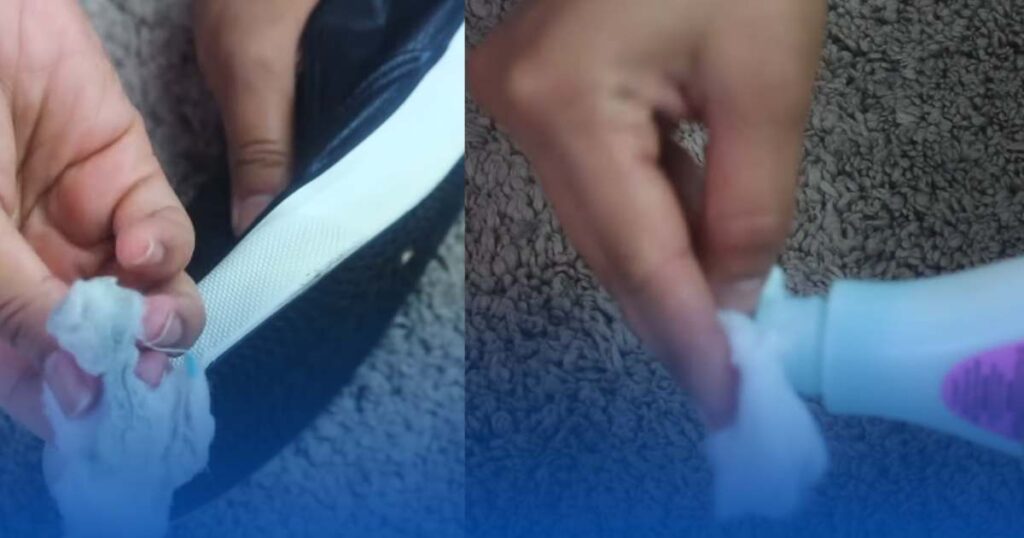
Cleaning Rubber Soles: A Detailed Tutorial
Rubber soles are a popular choice for many types of shoes due to their durability and traction. However, over time, these soles can accumulate dirt, grime, and even stubborn stains. Follow this step-by-step guide to effectively clean your rubber soles and restore their original appearance:
- Remove loose dirt: Start by tapping the soles together or against a hard surface to dislodge any loose dirt or debris.
- Prepare a cleaning solution: In a bowl, mix warm water with a small amount of mild dish soap or laundry detergent. Avoid using harsh chemicals or bleach, as they can damage the rubber material.
- Scrub with a soft brush: Dip a soft-bristled brush or toothbrush into the soapy solution and gently scrub the rubber soles. Pay attention to the grooves and crevices to remove embedded dirt. Use circular motions to effectively lift the grime.
- Rinse with clean water: Once you’ve thoroughly scrubbed the soles, rinse them with clean water to remove any soap residue. Make sure to remove all the soap to prevent any slippery surfaces on your shoes.
- Dry the soles: Pat the rubber soles with a clean towel to remove excess water. Avoid exposing them to direct heat sources like radiators or sunlight, as it can cause the rubber to deteriorate.
- Optional step for tough stains: If you’re dealing with stubborn stains on your rubber soles, you can create a paste using baking soda and water. Apply the paste to the colour, let it sit for a few minutes, then scrub gently with a brush. Rinse thoroughly and dry as mentioned above.
Cleaning Leather Soles: Step-By-Step Instructions For Optimal Results
Leather soles require special care to maintain their quality and extend their lifespan. Here’s a step-by-step guide to effectively clean your leather soles without causing any damage:
- Remove loose dirt: Use a soft brush or cloth to remove any loose dirt or debris from the leather soles. Be gentle to avoid scratching or scuffing the leather.
- Apply leather cleaner: Use a small amount of leather cleaner on a clean cloth or sponge. Rub the cleaner onto the leather soles in circular motions. Ensure you cover the entire surface evenly.
- Gentle scrubbing: If there are any stubborn stains or spots on the leather soles, you can gently scrub the affected area using a soft-bristled brush or toothbrush. Be careful not to apply excessive pressure.
- Wipe off excess cleaner: Use a clean, damp cloth to remove any excess leather cleaner from the soles. Make sure to wipe thoroughly to prevent the cleaner from drying on the leather.
- Conditioning the leather: After cleaning, it’s essential to prepare the leather to keep it moisturized and supple. Apply a leather conditioner or moisturizer according to the product instructions. It will help restore the natural oils and prevent cracking.
- Allow drying time: Let the leather soles air dry naturally. Avoid using direct heat or sunlight, as they can cause the leather to dry out and crack.
Cleaning Synthetic Soles: Tips And Tricks To Restore Their Appearance
Synthetic soles, often made from materials like PVC or TPU, are commonly found in athletic shoes and casual footwear. To keep your synthetic soles looking fresh and clean, follow these tips:
- Remove surface dirt: Use a soft brush or cloth to wipe away any loose dirt or debris from the synthetic soles. This initial step will make the cleaning process more manageable.
- Create a soapy solution: Mix warm water with a small amount of mild detergent or liquid soap in a bowl. Stir the solution until it’s well blended.
- Wipe the soles: Dip a clean cloth or sponge into the soapy solution and wipe the synthetic soles. Focus on areas with stains or dirt buildup to remove them effectively. Avoid applying excessive pressure, as it may damage the material.
- Rinse thoroughly: Once you’ve wiped the soles, rinse them with clean water to remove any soap residue. Ensure all the soap is rinsed off to prevent a slippery surface.
- Dry with a towel: Pat the synthetic soles gently with a clean towel to remove excess moisture. Avoid using a high heat source or direct sunlight, as it can cause the material to warp or melt.
- Air dry completely: Allow the synthetic soles to air dry completely before wearing the shoes again. It will ensure that no moisture remains, preventing any discomfort or odour.
Remember, by regularly cleaning and maintaining the soles of your shoes, you can extend their lifespan and keep them looking their best. Following these step-by-step guides for specific sole types will help you achieve optimal results and restore their appearance effectively.
Additional Tips For Effective Shoe Sole Cleaning
Maintaining clean and well-maintained shoe soles is essential not only for appearance but also for hygiene purposes. Here are some additional tips to help you effectively clean your shoe soles and keep them in top condition:
Preventive Measures To Minimize The Frequency Of Cleaning Shoe Soles
- Use shoe covers or protective sprays: Consider using shoe covers or sprays designed to repel dirt and debris. It can help prevent dirt buildup on your shoe soles and reduce the frequency of cleaning.
- Wipe soles after each use: Get into the habit of wiping your shoe soles with a damp cloth or baby wipe after each use. This quick and simple step can remove loose dirt and prevent it from settling and hardening on the soles over time.
- Avoid high dirt areas: When possible, try to avoid walking on muddy or filthy surfaces. By being mindful of the terrain you walk on, you can minimize the amount of dirt that clings to your shoe soles.
Advice On Maintaining The Cleanliness Of Shoe Soles In Different Environments
- Outdoor environments: To maintain clean shoe soles in outdoor environments, try using a stiff brush or toothbrush to scrub away any dirt or debris. Add a mild detergent or shoe cleaner to help loosen stubborn stains if needed. Rinse thoroughly and allow the soles to air dry completely before wearing them again.
- Indoor environments: For routine cleaning of shoe soles in indoor environments, wipe them with a damp cloth or sponge. Use a mixture of water and mild soap or a shoe-cleaning solution for a more thorough cleaning. Dry the soles entirely before wearing the shoes.
- Specialized shoe soles: Different shoe soles may require specific cleaning methods. Check the manufacturer’s guidelines or research online for instructions on how to clean shoe soles made of materials such as rubber, leather, or synthetic compounds.
How To Tackle Stubborn Stains Or Deposits On Shoe Soles
- Baking soda paste: Create a thick paste by mixing baking soda with water. Apply the paste to the stained area and gently scrub with a toothbrush or soft brush. Allow it to sit for a few minutes before rinsing off with water.
- Vinegar solution: Mix equal parts vinegar and water in a bowl. Dip a cloth or sponge into the solution and wring out any excess liquid. Wipe the stained areas on the sole, paying attention to stubborn stains. Rinse with water and dry thoroughly.
- Magic eraser: Magic erasers can be effective in removing scuffs and stains from shoe soles. Dampen the eraser and gently rub the affected areas until the stains are gone. Make sure to rinse the sole afterwards and allow it to dry.
Remember, regular maintenance and proactive cleaning can go a long way in keeping your shoe soles clean and in excellent condition. By following these additional tips, you can keep your shoes looking fresh and extend their lifespan.
Ensuring Proper Drying And Maintenance
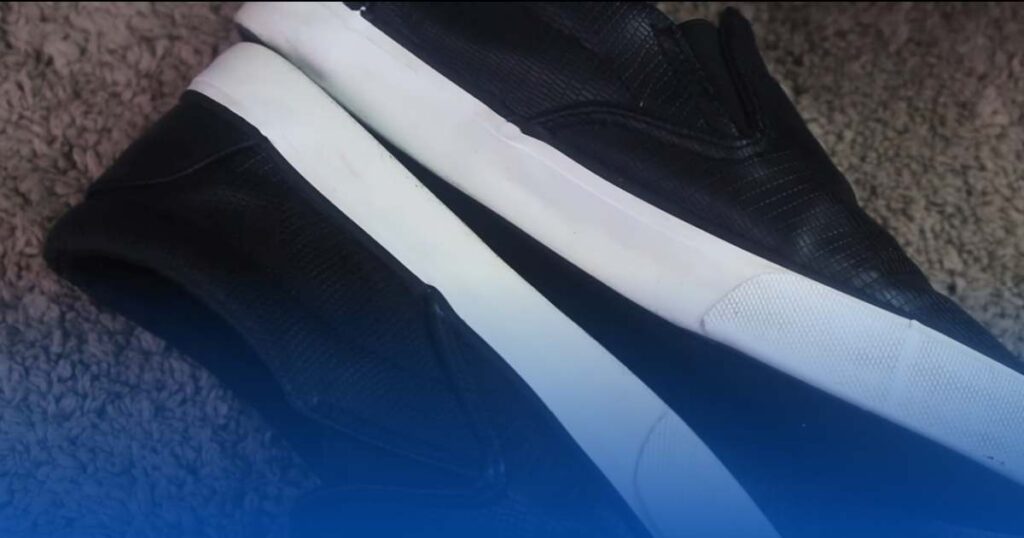
Maintaining clean shoe soles not only keeps your footwear looking good but also plays a crucial role in preserving their quality and longevity. Apart from regular cleaning, it’s essential to ensure proper drying and maintenance of shoe soles. This step-by-step guide will walk you through the significance of drying shoe soles correctly, proper storage techniques to preserve their cleanliness, and maintenance tips to enhance their lifespan.
Highlighting The Significance Of Drying Shoe Soles Correctly
When it comes to cleaning shoe soles, most people often overlook the importance of adequately drying them. However, this step is vital to prevent mould and bacterial growth, which can lead to unpleasant odours and potential damage to your shoes.
Here’s how to make sure your shoe soles dry effectively after cleaning:
- Give them ample time: Allow your shoe soles sufficient time to air dry completely before wearing them again. Depending on the material and weather conditions, this may take anywhere from a few hours to overnight.
- Avoid direct heat: While it may be tempting to speed up the drying process by using a hairdryer or placing them near a heater, this can cause damage to the soles. Excessive heat can warp, crack, or shrink the material, compromising its structure and performance.
- Optimize airflow: Promote proper drying by placing your shoes in a well-ventilated area. Open windows, use fans or put them outside in a covered, shaded spot to facilitate air circulation, which helps eliminate moisture.
Proper Storage Techniques To Preserve The Cleanliness Of Soles
After going through the cleaning and drying process, it’s essential to store your shoes in a way that maintains the cleanliness of the soles. Here are some storage techniques that can help:
- Please keep them in a clean and dry place: Store your shoes in a designated area that is clean, away from direct sunlight, and adequately ventilated. Avoid areas prone to moisture, such as basements or near windows.
- Use shoe bags or boxes: To protect the soles from dust and debris, consider using shoe bags or tubes for individual pairs. This not only prevents dirt buildup but also helps retain the shape of your shoes.
- Separate footwear: Store each pair of shoes separately to minimize the transfer of dirt and bacteria between them. It prevents cross-contamination and helps preserve the cleanliness of the soles.
Maintenance Tips To Enhance The Lifespan Of Shoe Soles
Proper maintenance of your shoe soles can significantly extend their lifespan, ensuring that they continue to support you on your daily adventures. Consider the following tips to optimize the performance and durability of your soles:
- Clean regularly: Regularly remove dirt, dust, and debris from the soles to prevent buildup, which can affect their grip and functionality. Use a soft brush or damp cloth to gently scrub away any particles.
- Rotate your shoes: Give your shoes a break by alternating between pairs. This allows time for the material and sole to recover from wear, reducing the impact on their lifespan.
- Check for wear and tear: Regularly inspect your shoe soles for signs of wear, such as thinning tread or cracks. If you notice any damage, consider having them repaired professionally or replacing them to avoid compromising your safety and comfort.
- Invest in quality footwear: When purchasing new shoes, prioritize brands known for their quality and durability. Opting for well-constructed footwear not only ensures the longevity of the soles but also provides better support and comfort for your feet.
By following these tips for proper drying, storing, and maintaining your shoe soles, you can keep them looking their best and extend their lifespan. Remember, consistency and attention to detail are vital in ensuring that your footwear remains clean, fresh, and ready for every step you take.
Frequently Asked Questions For How To Clean Shoe Soles
How Often Should I Clean Shoe Soles?
It is recommended to clean your shoe soles at least once a week to prevent the buildup of dirt, bacteria, and odors. Regular cleaning not only extends the life of your shoes but also helps maintain their traction and grip.
What Is The Best Way To Clean Shoe Soles?
To clean shoe soles effectively:
- Start by removing loose dirt and debris using a soft brush or toothbrush.
- Mix warm water with mild soap or detergent and gently scrub the soles using a sponge or cloth.
- Rinse thoroughly and allow them to air dry before wearing.
Can I Clean Shoe Soles In The Washing Machine?
While it may be convenient, it is not recommended to clean shoe soles in a washing machine. The machine’s agitation and water pressure can damage the soles or detach them from the shoes. Hand cleaning is the safest and most effective method to clean shoe soles.
Conclusion
Keeping your shoe soles clean is essential for maintaining the longevity and appearance of your footwear. By regularly cleaning them, you not only remove dirt and grime but also prevent any potential damage to the shoe material. In this blog post, we discussed various methods for cleaning shoe soles, from essential soap and water to more specialized products like baking soda or vinegar.
Remember to always check the manufacturer’s instructions before using any cleaning method. Additionally, proper storage and regular maintenance will also contribute to prolonging the life of your shoes. Clean shoe soles not only improve the overall look of your footwear but also help to maintain a healthier and cleaner living environment.

